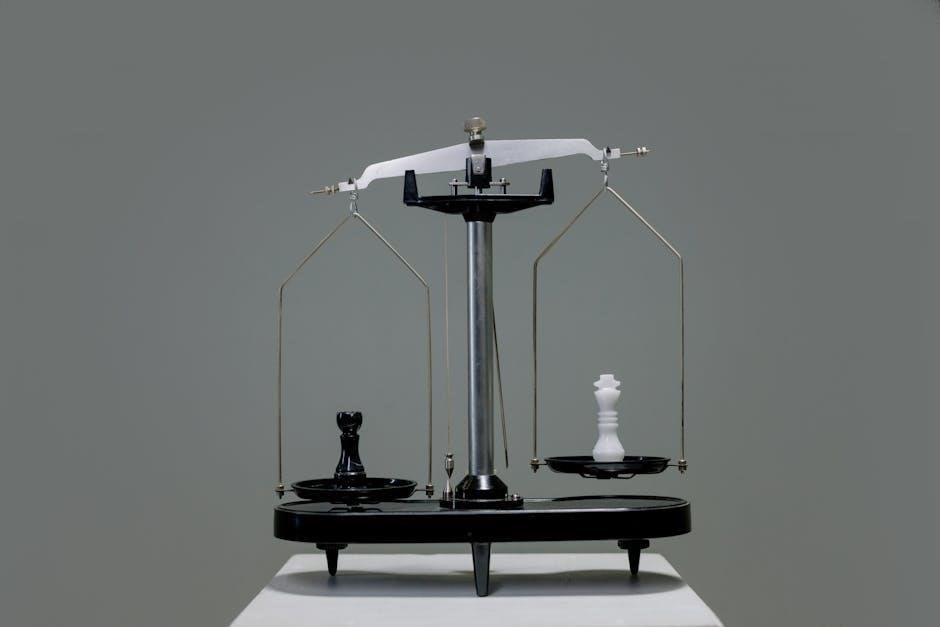The Mohs hardness scale was devised by Friedrich Mohs in 1812 as a method to determine mineral hardness using scratch tests with known standards and reference minerals easily․
History of Mohs Hardness Scale
The Mohs hardness scale has a rich history that dates back to 1812 when it was devised by Friedrich Mohs, a German geologist and mineralogist․ Mohs was working at the time as a curator of the Geographical Survey of Austria and was tasked with categorizing the various mineral specimens in the collection․ He developed the scale as a way to rank the minerals according to their scratch resistance, with the softer minerals being scratched by the harder ones․ The scale was initially based on ten minerals that were readily available at the time, and it has since become a widely accepted standard in the field of geology and mineralogy․ The development of the Mohs hardness scale marked an important milestone in the study of minerals and has had a lasting impact on the field․ Over time, the scale has undergone some modifications, but its basic principle remains the same․ The history of the Mohs hardness scale is a testament to the ingenuity and innovative spirit of Friedrich Mohs․
Understanding the Mohs Scale
The Mohs scale is a relative ranking of minerals according to their scratch resistance, with each mineral being able to scratch the ones below it on the scale․ The scale is based on the principle that a mineral with a higher ranking will scratch a mineral with a lower ranking․ The Mohs scale is not a linear scale, but rather a relative ranking, with no fixed difference in hardness between each point on the scale․ This means that a mineral with a ranking of 5, for example, is not necessarily twice as hard as a mineral with a ranking of 2․5․ The scale is also not a measure of other physical properties, such as density or cleavage․ To understand the Mohs scale, it is essential to recognize its limitations and to use it in conjunction with other methods of mineral identification․ By doing so, geologists and mineralogists can gain a deeper understanding of the properties and characteristics of minerals․ The Mohs scale is a fundamental tool in the field of geology and mineralogy․

Mohs Hardness Scale Table

Mohs scale table lists minerals with scratch resistance values for comparison purposes easily․
Mohs Hardness Scale Values
The Mohs hardness scale values range from 1 to 10, with higher values indicating greater resistance to scratching․ The scale is based on the ability of one mineral to scratch another, with a mineral that scratches another being ranked higher․ The values are assigned based on the scratch resistance of the mineral, with talc being the softest and diamond being the hardest․ The scale is a relative ranking, with no fixed difference in hardness between each point on the scale․ The Mohs hardness scale values are widely used in geology and mineralogy to identify and classify minerals․ The values are also used in industry to determine the suitability of minerals for various applications․ By understanding the Mohs hardness scale values, geologists and mineralogists can gain valuable insights into the properties and characteristics of minerals, and make informed decisions about their use and application․ The scale is an essential tool in the field of geology and mineralogy․
Modified Mohs Hardness Scale
The modified Mohs hardness scale is an extension of the original scale, with additional values and minerals included․ This scale provides a more detailed and nuanced classification of mineral hardness, allowing for more accurate identification and comparison of minerals․ The modified scale includes minerals such as garnet, fused zirconia, and silicon carbide, which are not included in the original scale․ The modified Mohs hardness scale is used in various fields, including geology, mineralogy, and materials science․ It provides a useful framework for understanding the properties and characteristics of minerals, and for selecting materials for specific applications․ The modified scale is also used in industry, where it is essential to determine the hardness and durability of materials․ By using the modified Mohs hardness scale, researchers and professionals can gain a deeper understanding of the properties and behavior of minerals, and make informed decisions about their use and application․ This scale is a valuable tool in the field of geology and mineralogy․

Importance of Mohs Hardness Scale
Mohs scale helps identify minerals and determines their hardness and durability effectively always․
Identifying Mineral Specimens
The Mohs hardness scale is a crucial tool in identifying mineral specimens, as it provides a simple and effective way to determine the hardness of a mineral․ By using the scale, geologists and mineralogists can quickly identify the hardness of a mineral and narrow down the possibilities for its identity․ The scale is particularly useful for identifying minerals that have similar appearances or properties, as it provides a clear and objective way to distinguish between them․ Additionally, the Mohs hardness scale can be used in conjunction with other tests, such as streak and luster, to provide a more comprehensive identification of a mineral specimen․ Overall, the Mohs hardness scale is an essential tool for anyone interested in mineralogy, and its use can help to ensure accurate and reliable identifications․ The scale is widely used in geological and mineralogical applications, and its importance cannot be overstated․
Comparison with Other Scales
The Mohs hardness scale is often compared to other scales, such as the Knoop and Vickers scales, which are used to determine the hardness of materials․ While these scales are more precise and accurate, the Mohs scale is still widely used due to its simplicity and ease of use․ The Mohs scale is also compared to the Rockwell scale, which is used to determine the hardness of materials such as metals and alloys․ However, the Mohs scale is more relevant to mineralogy and geology, as it is specifically designed to measure the hardness of minerals․ In comparison to other scales, the Mohs scale is relatively simple and does not require specialized equipment, making it a popular choice for fieldwork and initial assessments․ Overall, the Mohs scale remains a valuable tool in the field of mineralogy, and its comparison to other scales highlights its unique strengths and limitations․ The scale’s relevance and usefulness are still widely recognized today․

Applications of Mohs Hardness Scale
Mohs scale is used in various fields including mineralogy and geology for identification purposes easily always․
Mineralogy and Geology
The Mohs hardness scale is a fundamental tool in mineralogy and geology, used to identify and classify minerals based on their hardness․ Mineralogists and geologists use the scale to determine the hardness of a mineral by scratching it against a known standard․ This helps to narrow down the possible identities of an unknown mineral, making it an essential part of the identification process․ The scale is also used to study the physical properties of minerals, such as their crystal structure and chemical composition․ By understanding the hardness of a mineral, scientists can gain insights into its internal structure and behavior․ The Mohs hardness scale is widely used in geological surveys, mining operations, and research institutions, and is an important part of the toolkit for any mineralogist or geologist․ It provides a simple and effective way to characterize minerals and understand their properties․ The scale is also used in fieldwork and laboratory settings․
Industrial Applications
The Mohs hardness scale has numerous industrial applications, particularly in the manufacturing and construction sectors․ It is used to select materials for various applications, such as abrasives, cutting tools, and building materials․ The scale helps to determine the suitability of a material for a particular use, based on its hardness and resistance to wear and tear․ For example, materials with a high Mohs hardness are often used in abrasive applications, such as grinding and polishing․ In contrast, materials with a low Mohs hardness are often used in applications where flexibility and toughness are more important․ The scale is also used in the development of new materials and products, such as ceramics, glass, and plastics․ By understanding the Mohs hardness of a material, manufacturers can optimize its performance and durability, leading to improved product quality and reduced maintenance costs․ This information is widely used in various industries, including mining, construction, and manufacturing․
